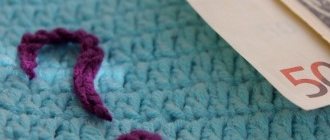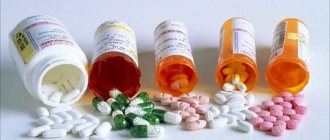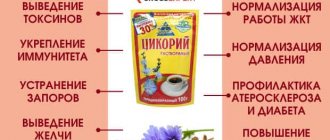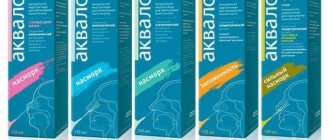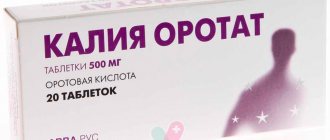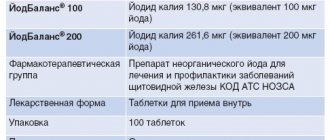Compound
The soft capsule in a gelatin shell contains 250 LE of the active substance sulodexide .
Additional components are: silicon dioxide (colloidal form), sodium lauryl sarcosinate, triglycerides.
The shell consists of titanium dioxide, gelatin, red iron oxide, sodium propyl parahydroxybenzoate, sodium ethyl parahydroxybenzoate and glycerol .
1 ampoule with a clear solution contains 600 LE of the active ingredient sulodexide. The auxiliary components are water and sodium chloride.
Release forms, composition and properties of the drug
The medicine is available in the form of a solution for parenteral administration. The liquid is transparent, has a yellow tint, and is packaged in ampoules of 2 ml. Ampoules are placed in cardboard boxes of 10 pieces, and they are always accompanied by detailed instructions for proper use.
In the pharmacy you can also find red soft gelatin capsules, packaged in plastic blisters of 25 pieces. An individual cardboard box may contain 2 plates of tablets and detailed instructions for proper use. The product in the form of a solution contains the active substance sulodexide, which has the main therapeutic effect.
Gelatin capsules also contain this ingredient. Its quantity in 1 capsule is 250 LE, in an ampoule with a solution the dosage is 600 LE. The solution contains sodium chloride and water for injection as an auxiliary ingredient. The capsules contain other additional substances, but they do not have therapeutic properties.
Wessel Due F - ampoules (analogs may have a different composition) that contain a solution with pronounced anticoagulant properties. The drug belongs to the group of direct anticoagulants and is prescribed to patients who suffer from various diseases accompanied by the formation of blood clots.
The main substance in the medicine also has other properties, which helps to have a complex effect on the body:
- Improves the condition of the vascular wall, stimulates the restoration of the integrity of the internal vascular wall.
- Makes blood vessels more elastic, which helps prevent damage and the development of external and internal bleeding.
- Improves microcirculation by reducing blood viscosity and easing the load on the vascular walls.
- Facilitates the work of the heart by reducing the load on the myocardium. As a result, the patient’s condition significantly improves, and the progression of the condition stops when diagnosing heart failure and some other pathologies.
- Prevents the formation of blood clots in patients with thrombophlebitis, varicose veins and some other peripheral vascular diseases.
Experts note the ability of the drug to reduce the level of bad cholesterol in the blood. As a result, the condition of blood vessels improves and the course of atherosclerosis is somewhat alleviated. With a mild form of the pathology, its progression stops.
After parenteral administration of the drug, rapid distribution of the ingredients of the composition through the systemic circulation is observed. The maximum concentration of the substance in the blood is detected after 30 minutes. The antithrombotic effect persists for 4 hours. The ingredient in the medicine does not accumulate in the blood or tissues; it is processed in the liver.
The elimination period takes no more than 6-8 hours. Pharmacokinetic features may differ in each case.
pharmachologic effect
Direct anticoagulant. The active ingredient is the natural component Sulodexide, isolated and extracted from the mucous membrane of the small intestine of pigs.
The active component consists of two glycosaminoglycans: dermatan sulfate and heparin-like fraction.
The drug has the following effects:
- angioprotective;
- anticoagulant;
- profibrinolytic;
- antithrombotic.
The anticoagulant effect is manifested due to the affinity of heparin for cofactor-2, under the influence of which the blood clot is inactivated.
The antithrombotic effect is ensured by an increase in the secretion and synthesis of prostacyclin, suppression of the active X factor, and a decrease in fibrinogen in the blood.
The profibrinolytic effect is achieved by reducing the level of tissue plasminogen activator inhibitor and increasing the level of the activator itself in the blood.
The angioprotective effect is associated with the restoration of adequate density of the minus electric charge of the pores in the vascular basement membranes. Additionally, the effect is ensured by restoring the integrity of vascular endothelial cells (functional and structural integrity).
Wessel Due F reduces triglyceride , normalizing blood rheological parameters. The active component is able to stimulate lipoprotease (a specific lipolytic enzyme), which hydrolyzes triglycerides, which are part of the “bad” cholesterol .
In diabetic nephropathy, the active substance Sulodexide reduces the production of extracellular matrix by suppressing the proliferation of mesangium cells; reduces the thickness of the basement membrane.
Description and composition
Sulodexide is used as the active component. This substance is extracted from the mucous membrane of the pig's small intestine and is therefore a natural product. It is a mixture of glycosaminoglycans. One of the well-known representatives of this group is heparin. Sulodexide predominantly contains a heparin-like fraction (80%) and dermatan sulfate (20%).
Briefly, the mechanism of blood clotting occurs as follows:
- When tissue is damaged, platelets are activated and transferred to the lesion. At the same time, the protein prothrombin is activated.
- The release of biologically active substances leads to vasoconstriction and functional ischemia. At this time, prothrombin is converted into thrombin.
- Thrombin helps convert a protein found in the blood plasma into an insoluble form (fibrin). It is this that forms the basis of the clot and thrombus, which tightly seals the site of injury and prevents bleeding.
Sulodexide has an affinity for cofactor II of heparin, as a result of which thrombin is inactivated and the subsequent chain of blood clot and thrombus formation is disrupted. In addition, sulodexide affects other coagulation factors and also reduces the concentration of protein in the blood plasma. Wessel DUE F has a positive effect on most stages of coagulation, maximally inhibiting this process. Due to the complex action, the anticoagulant activity of the drug is very high.
An additional advantage of the drug is the ability to restore the structure and function of vascular cells, increasing the density of their membranes.
In addition to the anticoagulant effect, Wessel DUE F improves the rheological properties of blood by reducing triglyceride levels.
Thus, the drug has the following pharmacological effects:
- Anticoagulant.
- Antithrombotic.
- Angioprotective.
- Profibrinolytic.
The high effectiveness of the drug is also due to the fact that 90% of the active substance enters the vascular endothelium. Here the concentration of sulodexide is 20 times higher than in other tissues.
Pharmacodynamics and pharmacokinetics
The drug is metabolized in the renal system and liver. The active substance does not undergo desulfation, unlike low molecular weight forms of heparin and unfractionated heparin.
Desulfation suppresses antithrombotic activity and significantly accelerates the process of elimination from the body.
The active component is absorbed in the lumen of the small intestine. 90% of the active substance is absorbed by the vascular endothelium. 4 hours after admission, Sulodexide is excreted from the body through the renal system.
Release forms and composition of the drug
Wessel Due F for oral administration is produced in the form of soft gelatin capsules with a dark red color. The capsule contains a white suspension (a cream shade is possible). Capsules are packaged in transparent cellular plates of 20 and 25 pcs. The package contains 50, 60 and 100 capsules.
Wessel Due F capsules contain:
Vessel Due F
| List of components | Description of the action of the components |
| Active ingredient of capsules | |
| Sulodexide (in the amount of 250 LE) | The substance prevents the formation of blood clots, promotes blood thinning, reduces the level of “bad” cholesterol, and the element also dissolves already formed clots in the blood, normalizes blood circulation and the condition of the walls of blood vessels. |
| Additional capsule ingredients | |
| Sodium lauryl sarcosinate | Improves absorption of the main component by the tissues of the digestive tract. |
| Silicon dioxide colloidal | It is an emulsion stabilizer, and the element also attracts pathogenic microflora (bacteria, allergens, decay products) and removes them from the body. |
| Triacetin | Used as a solvent and moisture retainer, and also has antimicrobial activity. |
| Capsule shell components | |
| Gelatin | The substance gives the capsule shell the required shape and also protects the contents of the capsule from the action of gastric juice. |
| Glycerol | The element is used as a binder, and the substance also has disinfecting properties. |
| Sodium ethyl parahydroxybenzoate (preservative) | Preservatives help extend the shelf life of capsules. |
| Sodium propyl parahydroxybenzoate (preservative) | |
| Titanium dioxide (bleach) | Substances give the shell the desired color and shade |
| Red iron oxide (dye) |
The manufacturer of the drug is an Italian pharmaceutical company.
Indications for use
- thrombosis , phlebopathy;
- pathology of cerebral circulation (acute period of stroke and recovery period);
- angiopathy with a high risk of thromboformation (after myocardial infarction );
- dementia of vascular origin;
- discirculatory form of encephalopathy caused by diabetes mellitus, total atherosclerosis , arterial hypertension ;
- microangiopathy (retinopathy, nephropathy, neuropathy);
- occlusive lesions of peripherally located arteries (against the background of diabetes mellitus and atherosclerosis);
- antiphospholipid syndrome, thrombolytic conditions (can be prescribed after low molecular weight heparin or together with acetylsalicylic acid);
- macroangiopathic changes in patients with diagnosed diabetes mellitus (encephalopathy, diabetic foot syndrome, cardiopathy );
- therapy for heparin-induced thrombotic thrombocytopenia
Vesel Due, instructions for use (Method and dosage)
In the first 15-20 days, the medication is administered parenterally. Intravenous and intramuscular injections are allowed. Intravenous administration can be drip or bolus.
Scheme: 2 ml (600 LE - 1 ml) of the contents of the ampoule are dissolved in a physiological solution with a volume of 200 ml. Upon completion of injection therapy, they switch to taking the drug in capsule form for 30-40 days. Twice a day, 1 capsule. The preferred time is between meals.
It is recommended to take 2 courses annually. The instructions for Vesel Due F contain an indication of the possibility of changing the above-described treatment regimen, taking into account individual characteristics, tolerance, and other concomitant diseases.
Analogues of the drug
An inexpensive Russian substitute for Angioflux with the main substance sulodexide. Belongs to the group of direct anticoagulants. Prescribed for the treatment of leg ischemia and angiopathy. Available in solution for intramuscular and intravenous injections and in gelatin capsules (orally).
Do not use in case of hypersensitivity to heparin, hypocoagulation, pregnancy, hemorrhagic diathesis.
Wessel Due F, a German substitute for Fragmin with sodium dalteparin as an active ingredient, is a direct anticoagulant.
Fragmin is prescribed subcutaneously and intravenously for many diseases with the risk of thrombosis:
- Myocardial infarction.
- Acute therapeutic diseases in bedridden patients.
- Angina pectoris is unstable.
- Surgical operations.
- Cancer diseases (long-term preventive treatment).
- Renal failure (prevention of blood clotting during hemofiltration).
According to studies, the use of the drug by pregnant women is considered justified and safe if the conditions are met (necessary indications and strict medical supervision).
Fragmin should not be used in the following cases:
- peptic ulcer of internal organs (duodenum, stomach) in acute form;
- with septic endocarditis;
- eye surgeries;
- immune thrombocytopenia;
- central nervous system operations;
- atypical changes in blood clotting;
- performing lumbar puncture;
- acute sensitivity to the active substance;
- It is prohibited to administer the drug intramuscularly.
Side effects
In the practice of treatment with the drug, there are isolated cases of negative effects.
- Thrombocytopenia is reversible and not immune.
- Immune thrombocytopenia.
- Alopecia.
- Itching.
- Rash.
- Anaphylactic manifestations.
- Hematoma.
Fragmin should be used with extreme caution in patients who are prescribed punctures, pregnant women, the elderly, those with renal failure, and diabetes mellitus. During treatment with Fragmin, it is necessary to regularly check the platelet count.
Anfiber - a substitute for Wessel Due F is a direct anticoagulant. Available in the form of a solution for injections. The active ingredient is sodium enoxaparin. Designed to prevent blood clots. It is not advisable to prescribe the drug to people with liver disease. There are very few side effects when used. The product cannot be used intramuscularly.
Enixum in the form of a solution for intravenous and subcutaneous injection with the active ingredient sodium enoxaparin is a direct anticoagulant.
Destination:
- vein thrombosis;
- prevention of thrombus formation in therapeutic diseases, surgical operations, hemodialysis, acute myocardial infarction, angina pectoris, heart failure, rheumatic and infectious diseases.
The product is not recommended for use during pregnancy. Spinal or epidural anesthesia should not be administered during treatment with the drug. It is prohibited to use the product for hemorrhagic stroke, threatened abortion, thrombocytopenia, cerebral aneurysm, and children under 18 years of age.
Careful use of the drug is recommended in the following cases:
- after ischemic stroke;
- arterial hypertension in severe form;
- severe diabetes;
- spinal puncture;
- CNS injuries;
- ulcers of internal organs;
- endocarditis;
- childbirth;
- tuberculosis;
- pericarditis;
- diabetic retinopathy;
- eye surgery;
- hypocoagulation;
- vasculitis in severe form.
The Italian drug Hemapaxan is a direct-acting prophylactic against coagulation and blood clots. The active ingredient is sodium enoxaparin. The finished product is produced in solution (syringes), packaged in cells and cardboard boxes. The cost of the drug depends on the dosage (0.6, 0.2 and 0.4 ml) 1200 – 1700 rubles.
During pregnancy, doctors diagnosed thrombophlibia. The hematologist prescribed the Italian drug Vessel Due F, first prescribed injections, ten procedures. Then I took two capsules of this medicine a day. There were no side effects. Analysis indicators have improved. But the doctors said that I needed to undergo more courses of treatment. The medicine is effective, however, it has a high price. But health is more important than money. I recommend this product to everyone. Just consult your doctor first. Health to everyone!
Olga, Voronezh
Analogues of Wessel Due F
Level 4 ATC code matches:
Angioflux
Hemapaxan
Fragmin
Fraxiparine
Clexane
Structural analogues:
- Sulodexide;
- Angioflux.
The price of analogues is significantly lower than the original drug.
Analogs
There are no analogues to the drug based on the active substance. Similar pharmacological effects have:
- Clexane. Available in the form of an injection solution. The active substance is enoxaparin. Each dose comes in a separate disposable syringe. Available in several dosages. Not used in pediatric practice.
- Flenox. The drug is made in Ukraine. Packages with different dosages are available in the pharmacy, which are packaged in 1, 2 or 10 syringes. For a long course of treatment, buying large packages is much more profitable.
- Athenative. Produced by an Austrian pharmaceutical company in dosages of 500 and 1000 IU. The active substance is human antithrombin III. It is a powder from which a solution for parenteral administration is prepared. A solvent comes in the package along with the medicine.
All drugs in this group are quite expensive. The price is justified by the high effectiveness of the drugs and the small number of side effects.
Heparin-based products, which are produced by different manufacturers, have a similar effect.
Wessel Due F during pregnancy (and lactation)
The drug should not be prescribed in the first trimester of pregnancy. The medical literature describes the positive experience of treating pregnant women with diagnosed type I diabetes mellitus with sulodexide late toxicosis during pregnancy.
The medication can be used in the 2nd and 3rd trimesters under the supervision of the attending physician and with the consent of an obstetrician-gynecologist or vascular surgeon.
Data on the safety of Wessel Due F during lactation are not found in the relevant literature.
special instructions
With long-term use of the drug "Wessel Due F", vascular surgeons recommend periodically monitoring the coagulogram.
Before undergoing a therapeutic course, it is necessary to check the following indicators:
- Antithrombin level 3.
- APTT indicator (treatment is not carried out if blood clotting indicators are low).
- Blood clotting rate.
- Duration of bleeding.
Similar studies are carried out at the end of the therapeutic course so that the real dynamics of treatment and possible negative effects of the drug on the properties of the blood can be tracked.
Under good conditions, the drug can increase APTT values by a maximum of 1.5 times. The drug does not affect the nervous system, so it can be used by patients even in situations where constant supervision by specialists is required.
The manufacturer does not recommend using the drug "Wessel Due F" during the first 3 months of pregnancy, but gynecologists advise women to exercise great caution and not resort to using the described medication without serious reasons and prior consultation with a doctor. Numerous reviews confirm that in the third trimester of pregnancy, women in 99% of all cases tolerate drug treatment with Wessel Due F well.
The drug also helps to overcome the painful symptoms of late toxicosis in pregnant women with diabetes mellitus, reduces the risk of developing vascular pathologies
Numerous reviews confirm that in the third trimester of pregnancy, women in 99% of all cases tolerate drug treatment with Wessel Due F. The drug also helps to overcome the painful symptoms of late toxicosis in pregnant women with diabetes mellitus, and reduces the risk of developing vascular pathologies.
Otherwise, anticoagulants can give unpredictable results when combined with alcohol, since ethanol will enhance the effect of the drug. The official instructions do not indicate anything about the consequences of using alcoholic beverages together with the drug "Wessel Due F", which is why it is better to consult a doctor to clarify this issue.
Wessel Due F price, where to buy
The cost of the medicine depends on the dosage form, pharmacy chain, and sales region.
The price of Wessel Due F capsules in Russia is 2800 rubles (tablets are not available).
The price of the ampoule is 200 rubles. You can buy the medicine at specialized pharmacies.
- Online pharmacies in RussiaRussia
- Online pharmacies in UkraineUkraine
- Online pharmacies in KazakhstanKazakhstan
LuxPharma* special offer
- Vessel Due F ampoules 600LE 2ml 10pcs
5380 RUR order
ZdravCity
- Wessel DUE F capsules 250 le 60 pcs. Catalent Italy S.p.A/Alfasigma S.p.A/Alpha Wassermann S.p.A
RUB 2,974 order
show more
PaniPharmacy
- Wessel Due F ampoule Wessel Due F solution d/in.
600 LSU amp. 2ml No. 10 Italy, Alfa Wassermann 791 UAH. order - Wessel Due F capsule Wessel Due F capsule. 250 LSU No. 50 Italy, Alfa Wassermann
1179 UAH. order
show more
Side effects
A course of using Wessel Due F in oral form may be accompanied by the following side effects:
- headache, may be accompanied by impairment or loss of consciousness;
- congestion in the ears or severe dizziness;
- pain in the abdomen accompanied by nausea;
- vomiting or loose stools. The stool may become black and have a strong odor. Discoloration is typical in the presence of gastric bleeding;
- bloating in the lower abdomen, which may be accompanied by flatulence;
- the appearance of blood in saliva or feces caused by the development of gastric or intestinal bleeding (noted in the presence of pathologies in the organs of the digestive tract);
- rash and itching on the skin. Symptoms are a sign of an allergy to the components of the product;
- mental disorders manifested by a violation of the perception of the surrounding world (it seems distant and unreal);
- tremor of the limbs, both weak and strong. Depends on the dosage of the medication;
- double vision, blurred vision;
- flushing of the face and palpitations;
- decreased amount of urine per day due to compression of the urinary canal;
- pain and discomfort in the chest area;
- decreased iron concentration in the blood;
- subcutaneous hemorrhages. The symptom manifests itself with increased fragility of blood vessels;
- swelling of the tissues of the external genitalia;
- increased frequency of menstrual bleeding.
In rare cases, anaphylactic shock may develop (if the patient has a pronounced allergy to the components of the capsule). If at least one side effect occurs, you must stop using the medication and visit your doctor to adjust the therapy.
